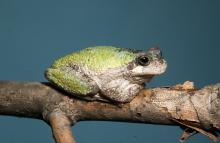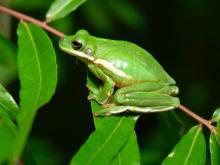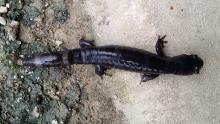Reptiles and Amphibians
Media

Species Types
Scientific Name
Hyla versicolor (Gray Treefrog) and Hyla chrysoscelis (Cope's Gray Treefrog)
Description
Sticky pads on fingers and toes enable Missouri's two gray treefrogs to climb and rest on vertical surfaces. You might occasionally see one resting on the siding of your house, if you live near suitable treefrog habitat.
Media

Species Types
Scientific Name
Hyla cinerea (syn. Dryophytes cinereus)
Description
The bright green treefrog hides perfectly among cattail leaves, where it rests until evening. Then it begins hunting for insects. In Missouri, it occurs mostly in the Bootheel.
Media

Species Types
Scientific Name
Hemidactylium scutatum
Description
A glacial relict in Missouri’s eastern Ozarks, the four-toed salamander lives among mosses in heavily forested streams and creeks and sinkhole ponds. It has a thick, round tail that is constricted at its base. There are four toes on each limb.
Media

Species Types
Scientific Name
Ambystoma opacum
Description
The marbled salamander is a small, stout salamander with silvery, white, or gray saddle-shaped markings on its body from head to tail. They occur in the southeastern half of the state and are seldom encountered except during the autumn breeding season.
See Also
About Reptiles and Amphibians in Missouri
Missouri’s herptiles comprise 43 amphibians and 75 reptiles. Amphibians, including salamanders, toads, and frogs, are vertebrate animals that spend at least part of their life cycle in water. They usually have moist skin, lack scales or claws, and are ectothermal (cold-blooded), so they do not produce their own body heat the way birds and mammals do. Reptiles, including turtles, lizards, and snakes, are also vertebrates, and most are ectothermal, but unlike amphibians, reptiles have dry skin with scales, the ones with legs have claws, and they do not have to live part of their lives in water.





















